Tokyo Metropolis has a lot to offer its visitors. Other than its busy streets and magnificent skyscrapers, it also houses the oldest temple in Tokyo, Senso-Ji (浅草寺). Learn more about this historic Buddhist temple, its legends, artifacts, architecture and surrounding areas!
Table of Contents
- All About Senso-Ji
- Enter the Senso-Ji
- Around Senso-Ji
- Things to do Around Asakusa
- Access to Senso-Ji and Other Info
- Summary
All About Senso-Ji
Senso-Ji is the oldest temple in Tokyo dedicated to the Bodhisattva Kannon who is also known as Avalokitesvara, the Goddess of Mercy and Compassion, and Guan Yin.
Legend of the Kannon Statue
Legend has it that in the year 628 (late Asuka Period), there were two sibling fishermen, Hinokuma Hamanari and Takenari, who fished up a golden statue in the Sumida River. The brothers presented the golden artifact toHajino Nakatomo, their village head who identified it to be a Kannon statue.
From thereon, Hajino Nakatomo dedicated his life to Buddhism. He surrendered his house and reconstructed it into a temple to house the Buddhist deity. He spent the remainder of his years in prayer and worship of Kannon. This was the foundation of Sensoji.
Growth of Senso-Ji
Around 2 decades later, a visiting Buddhist priest with the name Shokai Shonin came to know of the Kannon statue. He constructed a hall for the enshrinement of the statue. By divine revelation, he concealed the Kannon statue and it remains hidden to this day.
In the 9th century around 2 centuries later, head priest of Enryaku-Ji, Ennin visited Senso-ji whereupon he made an exact replica of the original.
As the years passed, the temple gradually gained popularity and as its devotees increased. Its devotees included distinguished figures in history including Shoguns during the Kamakura period, and the shogunate of the Edo Period by order of Tokugawa Ieyasu who declared Senso-Ji to be the official shogunate temple for prayers. The order by the first Tokugawa Shogun was abided by his successors of Shogun which contributed greatly to the spread of Kannon Buddhism teachings all over Japan.
※Asakusa Kannon Sensoji, “History of Senso-ji”
Writer's Pick
Enter the Senso-Ji
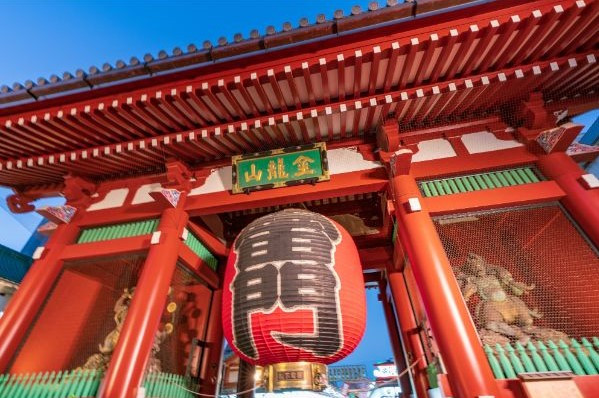
Now that we've covered the extensive history of Senso-Ji Temple, it is time to explore the temple grounds.
Kaminari-mon
You may recognize this famous symbol of Senso-Ji. Kaminari-mon or Furaijin-mon was originally built in 942 by Taira no Kinmasa. It has been destroyed and reconstructed several times, the latest reconstruction in 1960. Its most notable feature is its centrepiece, a gigantic vermillion paper lantern called Chochin (提灯 Paper Lantern) with its name - Kaminari-Mon (雷門: Thunder Gate) adorned on it. On both sides of the lantern are the temple’s guardian statues Fujin (God of Wind) and Raijin (God of Thunder).
Notice the green plate right above the Chochin? The inscribed words say Kinryuzan (金竜山) which means Golden Dragon Mountain. This is apparently the official name of Senso-Ji. Check the bottom of the Chochin, you will find a beautiful wooden carving of an Asian dragon.
Nakamise-dori
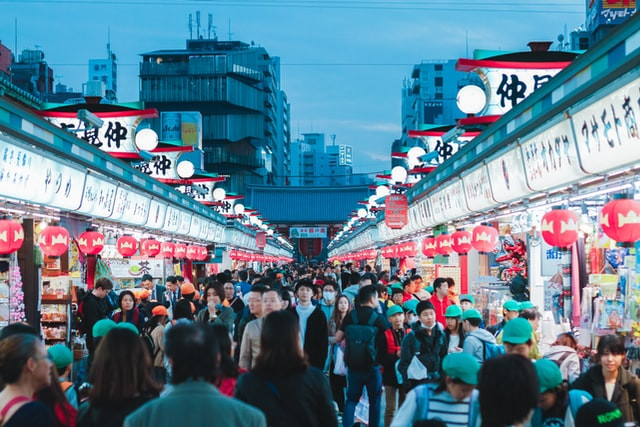
Crossing Kaminari-mon, you will find yourself on lively shopping street Nakamise-dori (仲見世通り) that leads to Hozo-mon. Ever since its establishment in the Edo Period of Japan, this has been a popular trading spot. This street has had its fair share of drama with destruction and reconstruction, and you can read more about it here.
In the present, with a total of 89 shops, it is the perfect place to shop with souvenirs like yukata, keychains, lucky figurines, accessories, chopsticks, folding fans, and more. Don’t forget to try out some traditional snacks like senbei (rice crackers), age-manju (fried manju), ningyo-yaki (doll pastries), kibi-dango (sticky dumplings), yokan (sweet agar), and more.
Hozo-mon
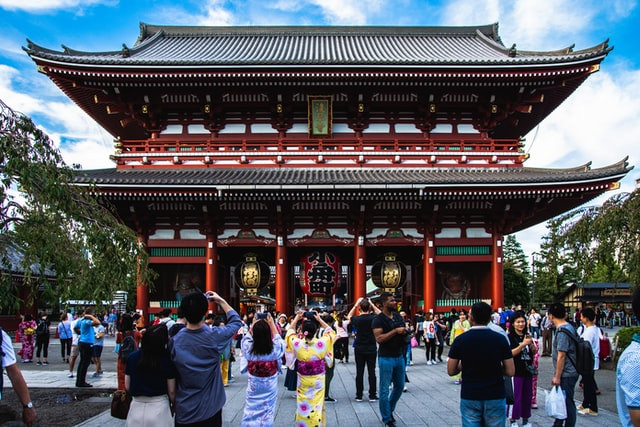
Hozo-mon (宝蔵門: Treasure House Gate) or Nio-mon was the second gate constructed by Taira no Kinmasa at the same time as Kaminari-mon. Having been destroyed and reconstructed several times, the current model was completed in 1964. There are 3 Chochin in the centre of the gate, one large red lantern with black lanterns on each side. The red lantern has the words Kobunacho (小舟町) engraved upon it, this is the name of the town that donated the lantern.
On both sides of the 3 lanterns are the temple’s Nio guardian statues said to ward off evil. On the other side of the gate behind the statues are Owaraji (大草鞋 Enormous Straw Sandals) weighing 2.5 kilograms each, these are said to belong to the Nio guardians.
Kannon-do
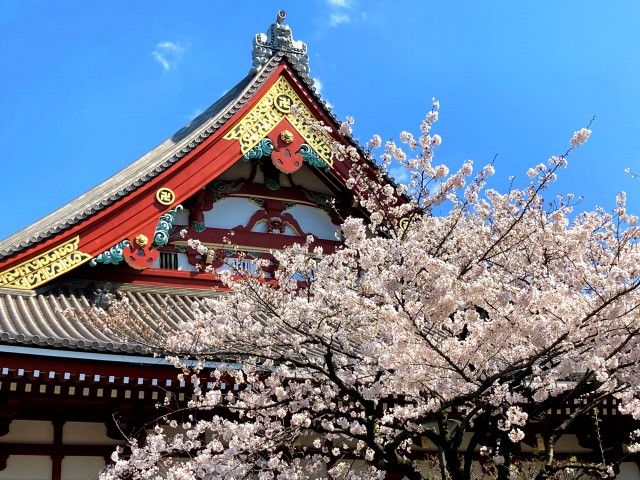
Finally, you will find yourself at the Kannondo (観音堂: Kannon Hall) or the temple's Main Hall which was constructed by Tokugawa Iemitsu. This national treasure suffered the same fate as most of the temple’s complex having been destroyed during the second World War. Thankfully, it was reconstructed in 1958. Rumour has it that the original golden statue of Kannon is hidden somewhere within this hall.
Right in front of the Hall is a large incense burner called Jokoro whose smoke is said to have healing properties. Believers stand near it to bask in and inhale the incense smoke.
To the Left of Kannondo
Yogo-do
The Yogo-do houses the Eight Buddhas who are protectors of an animal or two belonging to the zodiac including those born under the respective zodiac years. This is also the place to obtain a Goshuin (御朱印) - A collector shrine or temple seal stamp. It is a symbol that respect has been paid or a unique souvenir.
TIP: You can purchase Goshuin Book (御朱印帳) from Tokyu Hands or Loft. It is a unique souvenir and a fun activity to journey through shrines/temples collecting stamps.
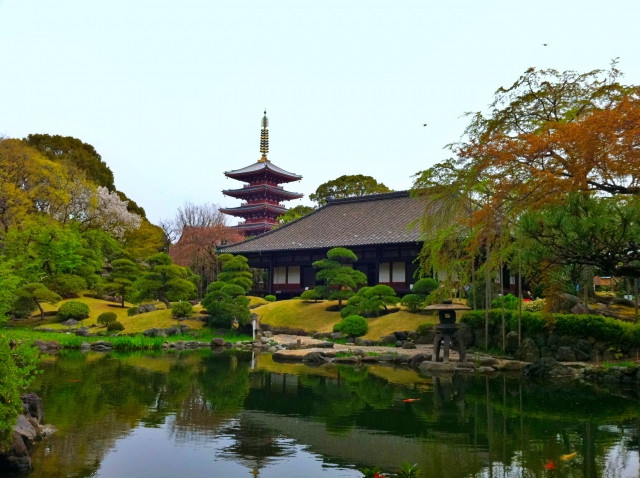
Five Story Pagoda and more
The temple’s left area includes the picturesque Five Story Pagoda which is a breathtaking sight when lit up at night.
Below the pagoda is Dembo-In (伝法院), the head priest’s residence, which is a registered National Cultural Property. Its garden is also recognized as a National Scenic Beauty, said to be a breathtaking sight. Unfortunately, for preservation purposes, the Dembo-In is usually closed to the public and only open for a few weeks in spring. You can try to call ahead of your trip requesting permission to visit the gardens but it is entirely to the temple’s discretion whether to allow it.
To the Right of Kannondo
To the right of Kannon-do are Benten-do and and registered National Cultural Property Niten-mon (二天門). Next to the Benten-do is a giant ornate bell known as the “time bell” that is struck at 6am daily, it has also starred in a famous haiku by Matsuo Bashuo.
Events in Senso-Ji
As one of the most visited temples in Japan, it is no surprise that Senso-Ji has a whole host of events throughout the year.
Check their annual calendar for the entire listing including Hatsumode (First Temple Visit of the Year), Setsubun (Spring Welcoming Celebration), Hana Matsuri (Buddha’s Birthday Celebration), and more.
Around Senso-Ji
Now, let's have a look around the neighborhood of Sensoji Temple, Asakusa, where you can spend the rest of your day.
Asakusa Shrine

Asakusa Shrine (浅草神社), also known as Sanja-sama, is closely related to Senso-Ji having been constructed in honour of the founders of Senso-Ji; the Hinokuma fisherman brothers and their chieftain. The three men are collectively known as the Sanja.
The shrine was established in 1649 by Tokugawa Iemitsu, the third Tokugawa shogun. It is officially recognized as a National Cultural Property.
The shrine is most famously known for its Sanja Matsuri held annually over 3 days on the third weekend of May. A grand festival once known as the 3 Great Edo Festivals, it attracts visitors from all over Japan. The highlight of the festival is the Daigoretsu (大行列) meaning large parade that consists of hundreds if not thousands of people carrying a hundred mikoshi (神輿 - A mini shrine or deity palanquin) through the Asakusa streets and spreading its blessings.
Asakusa Menchi
1-minute walk from Senso-Ji is Asakusa Menchi, a shop that sells only menchikatsu (メンチカツ Minced Meat Cutlet). There is usually a long queue but no worries it usually clears quite fast with 5-10 minutes wait occasionally when they need to fry up fresh menchikatsu. Next door is Toyofuku, a curry bread (カレーパン) specialty shop that you can try as well.
Things to do Around Asakusa
A quick visit to Senso-Ji would take half a day, why not explore the rest of the area whilst you’re here? Here are some places you can consider.
Asakusa Hanayashiki
Bring family or friends for some outdoor fun in Japan's oldest amusement park. Attraction rides include a roller coaster, haunted house, merry-go-round, 4D theatre, an observation deck with a view of Skytree, and more.
Note that an entrance fee is charged separately.
Entrance Fee: 1,000 yen (Adults)
Unlimited Rides Pass: 2,500 yen (Adults)
Single Ride: 100 yen per ticket, or 1,000 yen per ticket book (11 tickets)
Access: 1-min walk from Senso-Ji
Edo-Tokyo Museum
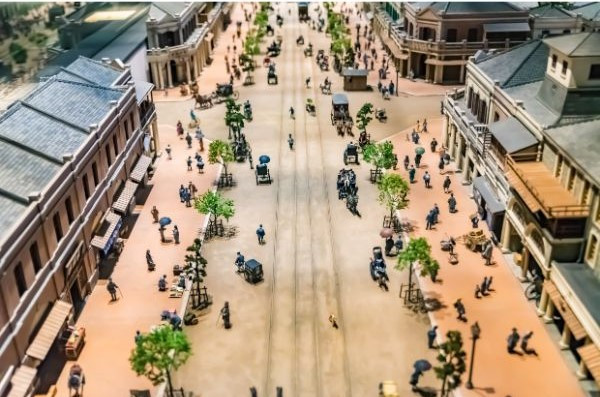
Discover the wonders of pre-modern Tokyo. Travel to the past and explore the history of Japan's Edo Period. Admire the adorable miniature scale of architecture, fashion and life back in those days.
Entrance Fee: 600 yen (Adults)
Access: 1-min from Ryogoku Station, or 23-mins walk from Senso-Ji
Tokyo Skytree

End the day with the tallest tower in the world, the Tokyo Skytree.
Access: 18-mins walk from Senso-Ji, or Oshiage Station, or via Tokyo Skytree Shuttle Bus from Kaminari-mon
Check out our dedicated article, Tokyo Skytree: A sight to commemorate.
Access to Senso-Ji and Other Info
There are several ways to get to Sensoji Temple. The temple itself is fairly close and only a 5-mins walk from Asakusa Station which you can access from different lines.
-
Tokyo Metro Ginza Line
-
Toei Asakusa Line
-
Tsukuba Express
-
Tobu Skytree Line
※ Asakusa Kannon Sensoji
Temple Hours and Fees
Free admissions to the temple complex that is always open. However, Kannon-do is open from 6 am until 5 pm in spring and summer, and from 6:30am until 5pm in autumn and winter. Also note that there is a
Senso-Ji at Night
The temple is lit up from sunset to 11pm every day. The sight of the 5 story pagoda and Kannon-do bathed in bright orange light is beautiful, so prepare your camera and be there for the taking.
Summary
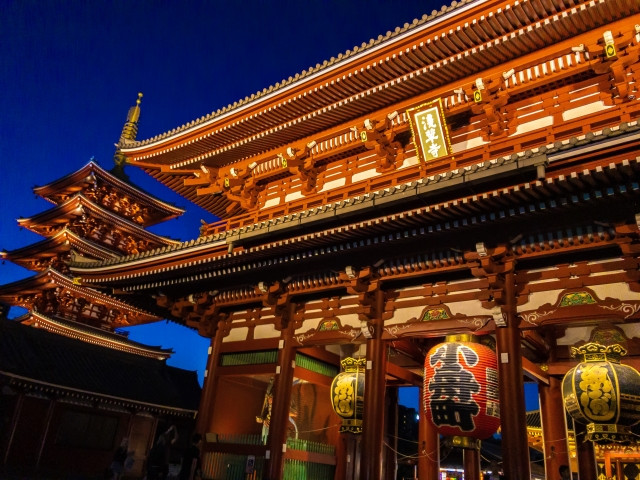
A trip to Tokyo is not complete without visiting the legendary Senso-Ji. With its rich history, beautiful landscapes, sights and sounds of a bustling crowd, and let’s not forget souvenirs and tasty treats, it truly embodies the heart and soul of traditional yet modern Tokyo.
※ Asakusa Kannon Sensoji











.jpg)

















